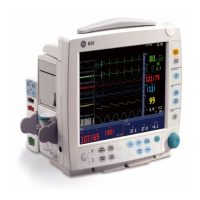B30 Patient Monitor
2-30
Performance
WARNING Operation of the monitor outside the specified values may cause inaccurate
results.
Any fluctuations within the specified limits do not affect the performance.
NOTE: Information in this section can be especially useful to clinicians.
Power supply
Rated voltages and frequencies: 100 to 240 V 50/60 Hz
Allowed voltage fluctuations: ±10 %
Maximum power consumption: 150 VA
Battery operation
Batteries: Exchangeable lithium-ion, 2 pcs max.
Charging time: 2 hours per battery pack
Operation time: up to 4.5 hours
Environmental conditions
Operating temperature:
normal operation: +5 to +40°C (41 to 104°F)
while charging batteries: +5 to +35°C (41 to 95°F)
Storage and transport temperature: -20 to +60°C (-4 to 140°F)
Relative humidity: 10 to 90 % noncondensing
Atmospheric pressure: 670 to 1060 mbar (500 to 800 mmHg)
Alarm behavior
The maximum alarm delay of the alarm at the monitor signal output to network: 5 seconds
If the alarm mode is latched, the technical alarms are latched as well. This does not comply with the NIBP
(IEC 60601-2-30) and invasive pressure (IEC 60601-2-34) standard requirements.
Silencing alarms for 5 minutes does not comply with the SpO
2
(ISO 9919) standard requirements.
Defibrillator & IABP synchronization connector
Analog output
ECG:
From first user lead (ECG1)
Gain: 1 V/mV ±10%
Delay: < 15 ms
DC offset: ±100 mV max.
Frequency response: 0.05 Hz to 40 Hz
Invasive blood pressure:
From pressure labeled ‘Art’
Gain: 10 mV/mmHg ±2%
Delay: < 35 ms
DC offset: ±20 mV max.
Frequency response: DC to 30 Hz
The pacemaker pulses have been replaced with 2 ms ±20% fixed digital pulses at the ECG analog output.
A device that fulfils the requirements of the IEC 60601-1 standard can be connected to the defibrillator &
IABP synchronization connector. There are no other limitations, because the signals of the connector are
galvanically isolated from patient applied part of the ECG and invasive blood pressure measurements.

